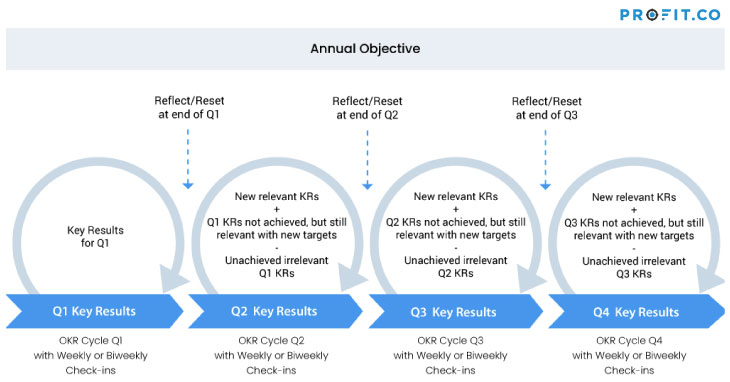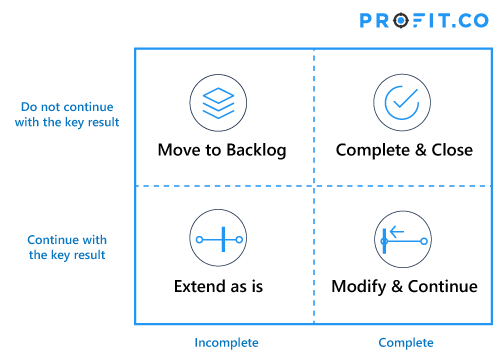OKR is a way of life in business. As in life, you need periodic checks to make sure you are marching in the right direction. While you check-in more frequently, quarterly Reflect/Resets allow your OKRs to be reviewed holistically and adjusted for the next quarter. The key idea of Reflect/Reset is this — What are we going to do differently this time?
It enables you to reflect on the achievement for the current quarter (celebrate!!!) and apply the learnings to reset them for the next quarter. To help with this learning, Profit allows you to define your “reflection” questions and capture your learnings by simply answering them. You would then reset the KRs for the next quarter.

When you start a new objective in a quarter, you typically start with 3-5 key results for that quarter. As you progress through the quarter, you check-in on your key results. In general, you don’t end up accomplishing all your KRs in the quarter you started.
At the end of the quarter, you go through a reflect and reset process to assess how you did and also plan for the next quarter.
We do not learn from experience. We learn from reflecting on experience.
The Reflection Process
The reflection process is pretty simple. You have a standard set of questions that you answer as part of your assessment. Some examples are:
- Did you accomplish your Objective?
- If yes, What contributed to your outcome?
- If No, What challenges did you face?
- What have you learned from the past quarter that might change your next quarter’s OKR?
- What needs to be adjusted, added or eliminated from your OKR?
- What did you do in the last quarter, which you didn’t like about?
- What you felt that you did well, but didn’t do well?
- What do you want to achieve in the next quarter?
These are just samples — you can decide what makes sense, and at what levels. So, the questions that matter most at the corporate level may not matter at the department level and vice versa.
Insanity: doing the same thing over and over again and expecting different results.
The Reset Process
Before you start thinking about resetting your key results, you should really look at the objective itself. Is the objective relevant to be continued into the next quarter? If the answer is yes, then you start looking at the key results.
At the end of your quarter, your key result’s progress is either:
- Complete or
- Incomplete
Depending on business conditions, you can either:
- Continue with the key result
- Do not continue with the key result
Based on these two decisions, you can decide the appropriate course of action on the key result:

1. Extend as is
The key result is not complete but is still relevant. So, you continue with the key result as is. For example, you wanted to establish a retail location in Manhattan, but you are just 40% of the way there. This key result is still relevant, but there is no need to modify the target and hence we just extend this key result as is.
2. Move to Backlog
The key result is not complete but is not relevant in this upcoming quarter.
3. Reset progress and restart
The key result is complete, but you want to modify the numbers and continue because the key result is still relevant. For example, you wanted to solve 40 issues in the product and you ended up solving 30 issues. Now, this key result continues to be relevant. So, you can start with the 30 you’ve already fixed and reset your target to 70 or something around there to get you going in the next quarter.
4. Complete and Close
The key result is complete, and hence can be closed. #Celebrate


